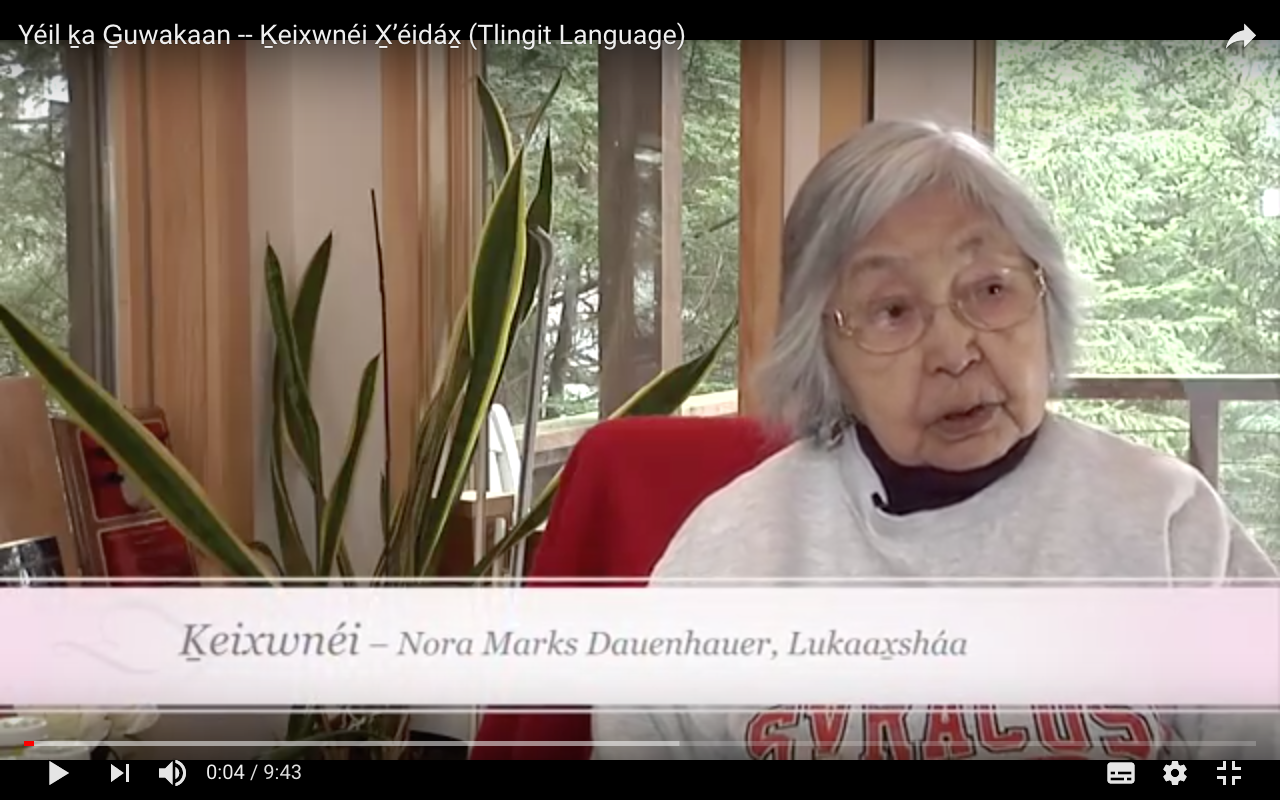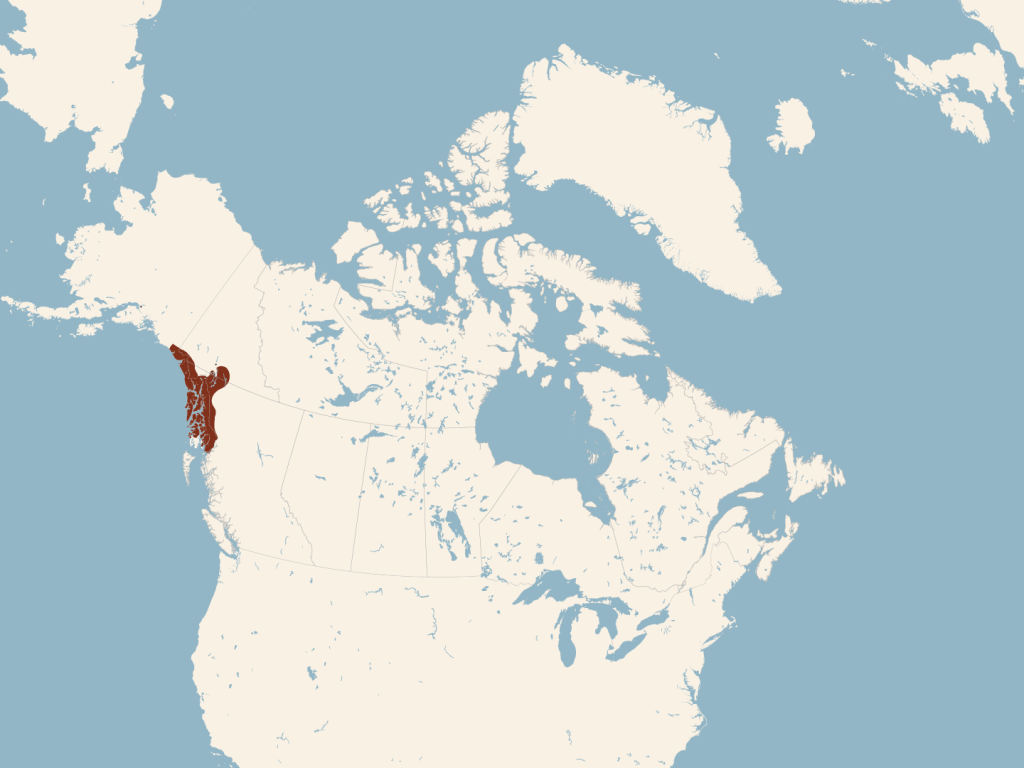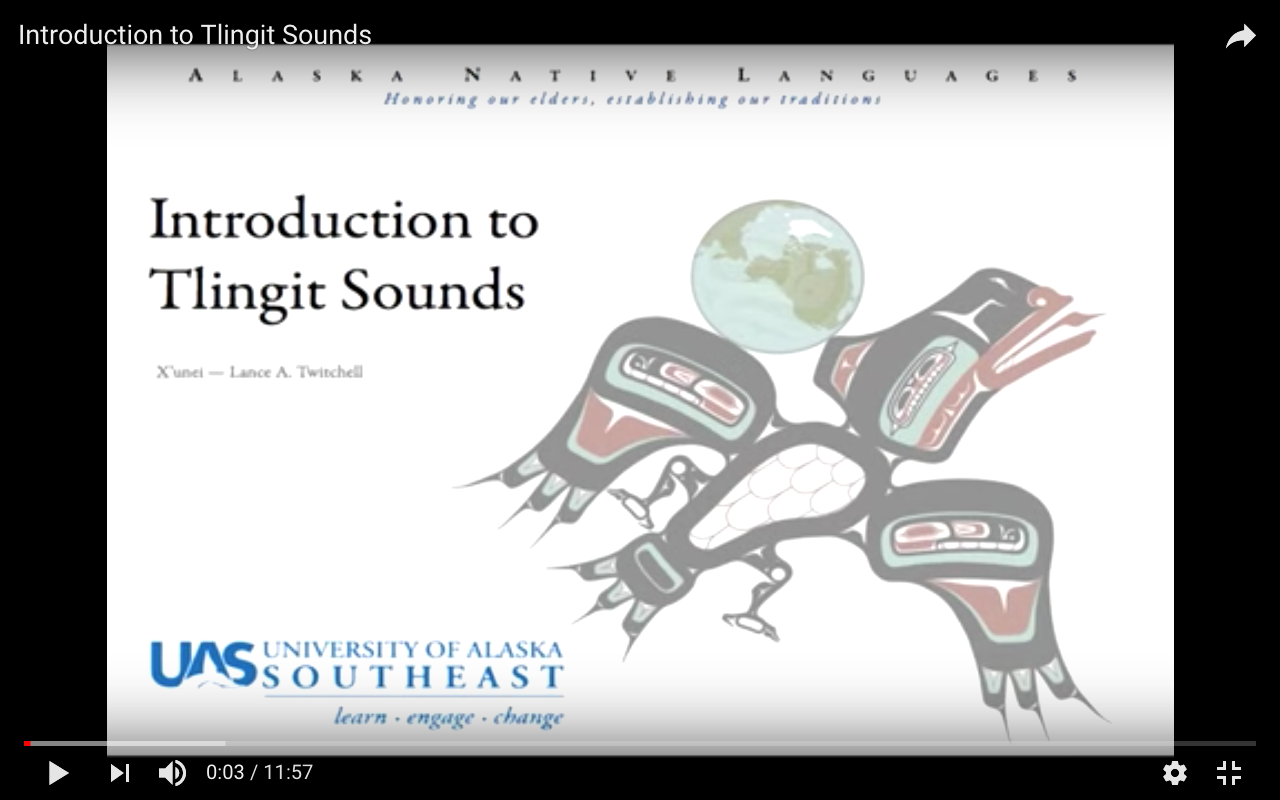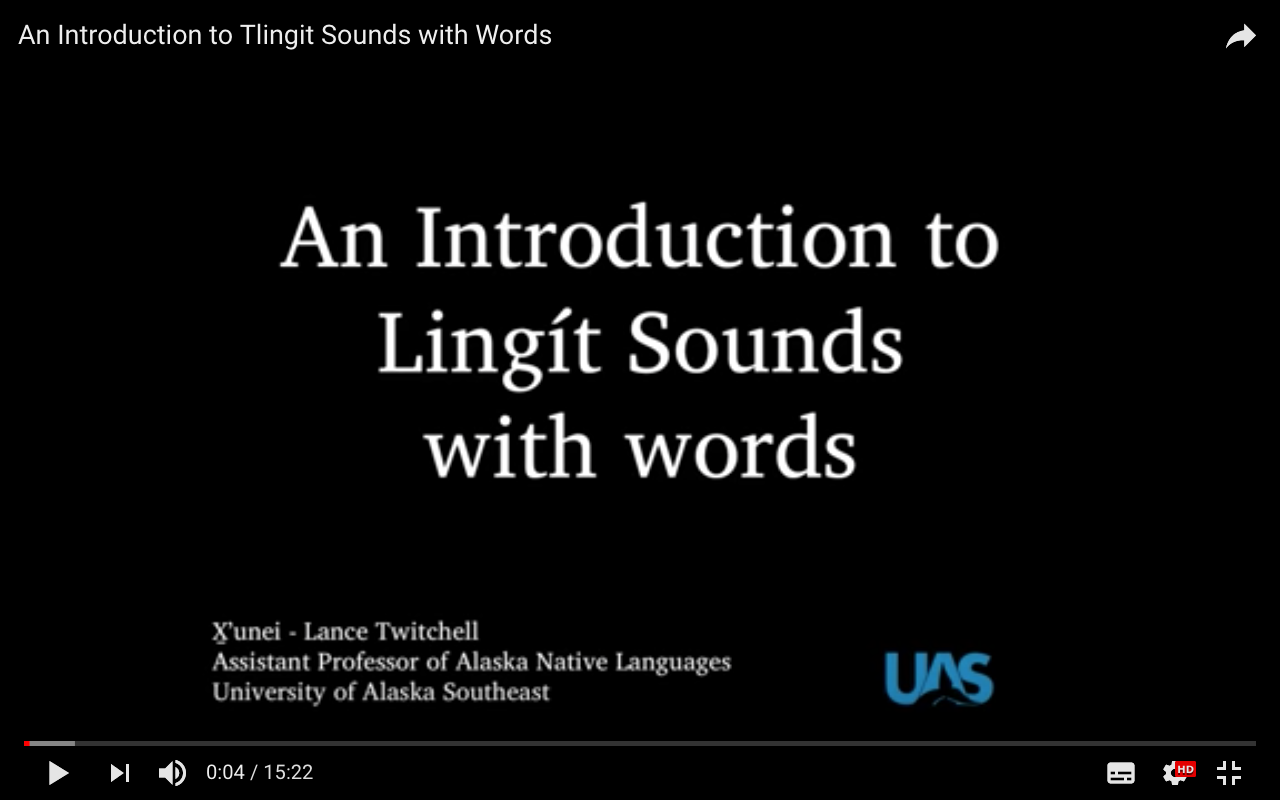Table of Contents
Tlingít in Alaska, United States of America
Language designations:
Language vitality according to:
Click here for a full overview of the language vitality colour codes.
Linguistic aspects:
- Classification: Athabaskan-Eyak-Tlingit → Tlingit. For more information see Tlingít.
The Athabaskan language family is also often referred to as Na-Dené. Linguists estimate that Tlingít split off from common Athabaskan (Na-Dené) about 5,000 years ago 2). Some, however, consider Tlingít an isolate language (Campbell 1997) 3).
- Script: Latin Script. In Alaska, the Cyrillic Script was used prior to the Alaska purchase.
- What it is sounds like:
Language standardization
There are currently three orthographies, two of which are commonly used in Alaska 4).
The Canadian orthography was developed in the 1980s by the Yukon Native Language Center, and it is intentionally similar to orthographies used by other Athabaskan languages in Canada.
The so-called American orthography was developed in the 1960s by Constance Naish and Gillian Story to represent all the Tlingít phonemes. It later underwent some modifications in native hands, and in the 1970s Nora and Richard Dauenhauer published a Tlingít spelling book 5). It is the most commonly used system nowadays in Alaska.
Tlingít can also be spelt using the so-called e-mail orthography, which is a simplification of the American orthography. The system replaces the underscore diacritic (e.g., ták̲l), used to represent uvular consonants, with a digraph of the velar consonant plus h (e.g., tákhl). Its use has become more common with new technologies, since it can be easily input on a computer using an extended US keyboard.
Demographics
Language Area
Tlingít is the language of the Tlingít people, native to Southeast Alaska and Western Canada, from Yakutat to Ketchikan. It is spoken in an area that extends from the mouth of the Copper River down to the Gulf of Alaska and most of the islands of the Alexander Archipelago 6).
Almost all the Tlingít territory is currently within the borders of Alaska, with the exception of Inland Tlingít. This covers an area of northern British Columbia and southern Yukon (Canada) up to the Taku River and around the Atlin and the Teslin Lake, as well as a small concentration around Bennett Lake 7).
However, most speakers are nowadays found in and around Juneau, Alaska 8).
Dialects
Tlingít is divided in five major dialects, which are mostly mutually intelligible 9).These can also be classified as two-tone dialects, three-tone dialects and non-tonal dialects.
- Yakutat or Northern Dialect. It it is the most widely spoken dialect.
- Transitional dialect
- Southern dialects of Sanya and Heinya.
- Inland Tlingít, spoken in Canada.
- Tongass Tlingít, the last native speaker of which died in the 1990s. It is the only non-tonal Tlingít dialect, presenting a four-way register contrast instead (showing contrast between short, long, glottalized and fading vowels).
Map showing the areas where Tlingít was traditionally spoken 10).
Speaker Numbers
In the census, it is estimated that there are around 1,360 speakers of Tlingít 11) 12), 1,240 in Alaska 13).
Other organizations, however, give much lower figures: 300 (UNESCO), 500 (Linguamón) 14), which seems to be more in tune with the figures given by community surveys, which estimate between 200 and 400 fluent speakers in the US and around 100 in Canada 15).
Out of an estimated 17,371 ethnic Tlingít population (16,771 in Alaska 16) and 600 in Canada 17)), around 8% claim to be able to speak Tlingít (1,360), but the most optimistic community estimates lower it to around 3% of fluent speakers.
Education of the language
History of language education:
Alaska was first settled by Europeans (Russians) in the late 18th century, who introduced bilingual programs in the native languages and Russian and even forced the displacement of large numbers of Aleuts, who were sent to Moscow. Alaska was later sold to the US in 1867 (Alaska purchase), and a policy of English only was established in schools. From the late 1800s to the mid-1900s the federal government separated families and forced native children into boarding schools in a large-scale assimilation campaign 18). Tlingít was strictly forbidden, and kids were punished if they were heard using the language.
However, some could escape this fate and some cities (e.g., Kake) started having their own school system in 1951, where the native language could be spoken 19).
When Alaska became the 49th state of the US, in 1959, this system had already finished, but the English only policy was still very strong. With the Civil Right Movement, however, the natives started demanding more self-determination (Alaska is, along with Hawai'i, one of the only two territories in the US where the natives do not have sovereignty treaties with the federal government) and some bilingual education was started in 1965 20).
Moreover, in 1971 the Alaska Native Claims Settlement Act was passed and Alaska Natives received title to 40 million acres of land and 962.5 million dollars in compensation, and new schools were built after that in areas inhabited predominantly by native population 21).
Finally, on 23rd October 2014, Alaskan representatives passed House Bill 216, entitled: “An act adding the Inupiaq, Siberian Yupik, Central Alaskan Yup'ik, Alutiiq, Unangax, Dena'ina, Deg Xinag, Holikachuk, Koyukon, Upper Kuskokwim, Gwich'in, Tanana, Upper Tanana, Tanacross, Hän, Ahtna, Eyak, Tlingit, Haida and Tsimshian languages as official languages of the state” 22).
This bill made 20 native languages official languages of the state of Alaska alongside English (which had been made official in 1998) 23).
Legislation of language education
Federal legislation:
Tlingít is covered by the Native American Languages Act (S. 2167) passed in 1990.
Among other things, the act establishes that 24):
- the status of the cultures and languages of Native Americans is unique and the United States has the responsibility to act together with Native Americans to ensure the survival of these unique cultures and languages;
- the traditional languages of Native Americans are an integral part of their cultures and identities and form the basic medium for the transmission, and thus survival, of Nativa American cultures, literatures, histories, religions, political institutions and values;
- there is a widespread practice of treating Native American languages as if they were anachronisms;
- there is a lack of clear, comprehensive and consistent Federal policy on treatment of Native American languages and cultures;
- there is convincing evidence that student achievement and performance, community and school pride, and educational opportunity is clearly and directly tied to respect for, and support of, the first language of the child or student.
The act also advocates for a policy to, among others 25):
- preserve, protect and promote the rights and freedom of Native Americans to use, practice and develop Native American languages;
- allow exceptions to teacher certification requirements for Federal programs, and programs funded in whole or in part by the Federal Government, for instruction in Native American languages when such teacher certification requirements hinder the employment of qualified teachers who teach in Native American languages, and to encourage State and territorial governments to make similar exceptions;
- encourage and support the use of Native American languages as a medium of instruction in order to encourage and support Native American language survival, educational opportunity, increased student success and performance, increased student awareness and knowledge of their culture and history, and increased student and community pride;
- recognize the right of Indian tribes and other Native American governing bodies to use the Native American languages as a medium of instruction in all schools funded by the Secretary of the Interior;
- fully recognize the inherent right of Indian tribes and other Native American governing bodies, States, territories, and possessions of the United States to take action on, and give official status to, their Native American langauges for the purpose of conducting their own business;
- support the granting of comparable proficiency achieved through course work in a Native American language the same academic credit as comparable proficiency achieved through course work in a foreign language, with recognition of such Native American language proficiency by institutions of higher education as fulfilling foreign language entrance or degree requirements;
- encourage all institutions of elementary, secondary and higher education, where appropriate, to include Native American languages in the curriculum in the same manner as foreign languages and to grant proficiency in Native American languages the same full academic credit as proficiency in foreign languages.
State legislation:
In 2015 legislation was introduced to support the creation of immersion charter schools in Alaska. Even though there are plans to create an immersion Tlingit school 26), some studies have found that Tlingit efforts to establish immersion schools are hindered by a culture of teacher certification and required monolingual standardized testing (in English) 27).
As far as education in a Native Language is concerned ('native' is defined as a person of one-fourth degree or more Alaskan Indian, Eskimo or Aleut blood), AK Stat§ 14.30.420 (2016) establishes:
Title 14 - Education, libraries and Museums Chapter 14.30 - Pupils and Educational Programs for Pupils Article 10 - Bilingual-Bicultural education Section 14.30.420 - Native language education
- (a) A school board shall establish a local Native language curriculum advisory board for each school in the district in which a majority of the students are Alaska Natives and any school district with Alaska Native students may establish a local Native language curriculum advisory board for each school with Alaska Native students in their district. If the local Native language curriculum advisory board recommends the establishment of a Native language education curriculum for a school, the school board may initiate and conduct a Native language education curriculum within grades K through 12 at that school. The program, if established, must include Native languages traditionally spoken in the community in which the school is located. Each school board conducting a program of Native language education shall implement the program as a part of regular classroom studies and shall use:
- (1) instructors who are certified under AS 14.20.020 or 14.20.025; and
- (2) to the maximum extent possible, instructors and instructional materials available through the University of Alaska; and audio-visual, computer and satellite technology.
Institutional support for education of the language:
Language learning materials:
Most learning materials are developed by the teachers themselves, and often shared online (e.g., Lingít yoo x̲'atángi).
Other organizations also create materials, mainly Sealaska Heritage, the Alaska Native Language Center of the University of Alaska Fairbanks ( ANLC - Tlingit, the ANLC - Language Resources.
The creation of these materials may be funded by the different school districts (for Tlingit, especially the Juneau School District), the different Native Villages, the State of Alaska, the Federal Government of the United States, the Central Council of the Tlingit and the Haida Indian Tribes of Alaska (or CCTHITA) or private funding of different sorts.
Teacher training:
It is possible to get a Tlingit certificate at the different branches of the University of Alaska, but it is quite common for the elders to be the Tlingit teachers. This often encounters opposition by legislators, who require teacher certification 28).
Education presence
Kindergartens
There are plans to establish a Tlingit Language Nest (akin to those found for Hawaiian and Maori) 29).
Elementary, Middle and High Schools
In rural villages, where the large majority of students are Alaska Native, most schools offer some kind of instruction in Tlingit in the early years, and several incorporate Alaska Native issues, perspectives and traditional knowledge in the school or district curriculum. Community members may serve as classroom and bilingual teacher aides in nearly all village schools 30).
As for urban schools (the three largest cities in Alaska being Anchorage, Fairbanks and Juneau. Tlingit is spoken in the latter), which serve nearly 30% of Alaska Native students, the teaching of the language varies greatly depending on the city 31). In Juneau, some pupils are taught Tlingit once a week, typically in 30 to 40 minutes lessons, often taught by elders 32).
The Juneau School District plans to expand the teaching of Tlingit culture and language at its elementary schools to all students. Glacier Valley Elementary School started in 2015 a Tlingit language enrichment class, which was the first of its kind in Southeast Alaska 33).
The Juneau School District has recently implemented an Indian Studies program, whose objectives for the school year 2017-2018 include the increase of Native American / Alaska Native Language Instruction Programs 34).
Higher Education
Tlingit can be learnt at the University of Alaska Southeast 35), where you can even get a Tlingit Language Minor 36).
Tlingit is also taught at the University of Alaska Fairbanks 37) as part of their Alaska Language Classes and Degree Programs. They normally offer Yup'ik, Gwich'in and Tanana, but Tlingít courses are arranged upon request.
Tlingit is also taught at the University of Alaska Anchorage 38) as part of their Alaska Native Studies Program.
Others
Many initiatives have been put in place to teach children and adults outside school in Alaska. The different branches of the University of Alaska, as well as Sealaska Heritage, offer courses open to anyone. Moreover, several native villages have their own learning activities.
Two of the most successful initiatives are:
- Tlingit Language Learners Group, where learners are encouraged to use the language 41).
Online learning resources
Tlingít Sounds
Tlingít Sounds with words
Alaska Native Knowledge Network: Paulin Duncan's Tlingit Curriculum Resources
Alaska Native Knowledge Network: Tlingit phrases
Chilkat Indian Village: Tlingit Phrases, Colors and Greeting
Goldbelt Heritage Foundation: Talking on the Phone in Tlingít
Lingít yoo x̲'atángi: Beginning Tlingit
Lingít yoo x̲'atángi: Dictionary
Lingít yoo x̲'atángi: Integrating Tlingit
Lingít yoo x̲'atángi: Intermediate Tlingit
Lingít yoo x̲'atángi: Tlingit linguistics
Lingít yoo x̲'atángi: Tlingit oral literature
Lingít yoo x̲'atángi: Tlingit Transcription and Translation
Lingít yoo x̲'atángi: Tlingit verbs
Nora and Richard Dauenhauer: Aan Aduspelled X'úx' - Tlingit Spelling Book
Sealaska Heritage: Language for the kitchen in Tlingit
Sealaska Heritage. Materials to learn Tlingit
Sealaska Heritage: Tlingit Introduction Format
Sealaska Heritage: Tlingit Language Mentor-Apprentice Handbook
University of Alaska South East: Tlingit Conversation Documentation Project
X̱'unei Lance Twitchell: Youtube Channel to Learn Tlingít
White, F.: Sigóowu K̲áa Téix̲' Yagiyee - Happy Valentine's Day






